engine oil FIAT SCUDO 2014 Owner handbook (in English)
[x] Cancel search | Manufacturer: FIAT, Model Year: 2014, Model line: SCUDO, Model: FIAT SCUDO 2014Pages: 227, PDF Size: 4.45 MB
Page 20 of 227

16SAFETY
DEVICESCORRECT USE
OF THE VEHICLE
WARNING
LIGHTS AND
MESSAGESIN AN
EMERGENCYVEHICLE
MAINTENANCETECHNICAL
SPECIFICATIONSINDEXDASHBOARD
AND CONTROLS
Warning lights on the upper plate
On certain versions, the upper plate
fig. 12(located above the driving mirror)
can be fitted with the following warning
lights:❒
warning light indicating that the seat
belt is not fastened (<) (version with
two front seats).
❒
warning light indicating that the pas-
senger air bag is off (
“
)
INSTRUMENT PANEL
BRIGHTNESS ADJUSTER
To adjust the instrument panel brightness:
press button A-fig. 13
fig. 12
F0P0285m
DISPLAY The display fig. 14shows by the relevant
warning lights (see section “Warning lights
and messages”):❒
speed limiter / control;
❒
total km / mi covered;
❒
engine oil level gauge;
❒
water in diesel fuel filter;
❒
glow plug preheating.
According to versions the display shows
the time. Setting the clock through the
instrument panel display
To set the clock through the instrument pan-
el display, use button A-fig. 15as follows:
❒
turning the button leftwards makes the
minute value flash;
❒
turning the button rightwards will in-
crease minute value (keep the button
turned rightwards to speed up rolling);
❒
turning the button leftwards makes the
hour value flash;
❒
turning the button rightwards will in-
crease hour value (keep the button
turned rightwards to speed up rolling);
❒
turning the button leftwards selects
24H or 12H mode display;
fig. 14
F0P0291m
fig. 13
1/2
F0P0353m
001-019 SCUDO LUM GB 19/11/13 08.26 Pagina 16
Page 22 of 227
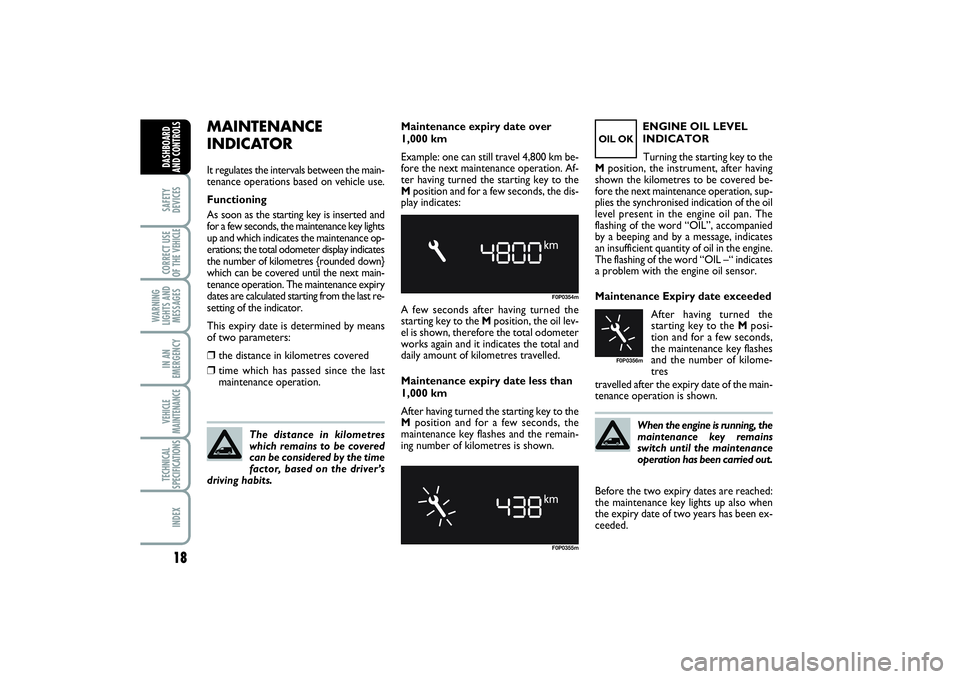
18SAFETY
DEVICESCORRECT USE
OF THE VEHICLE
WARNING
LIGHTS AND
MESSAGESIN AN
EMERGENCYVEHICLE
MAINTENANCETECHNICAL
SPECIFICATIONSINDEXDASHBOARD
AND CONTROLS
MAINTENANCE
INDICATORIt regulates the intervals between the main-
tenance operations based on vehicle use.
Functioning
As soon as the starting key is inserted and
for a few seconds, the maintenance key lights
up and which indicates the maintenance op-
erations; the total odometer display indicates
the number of kilometres {rounded down}
which can be covered until the next main-
tenance operation. The maintenance expiry
dates are calculated starting from the last re-
setting of the indicator.
This expiry date is determined by means
of two parameters:❒
the distance in kilometres covered
❒
time which has passed since the last
maintenance operation.
The distance in kilometres
which remains to be covered
can be considered by the time
factor, based on the driver’s
driving habits.
F0P0354mF0P0355m
OIL OK
F0P0356m
Maintenance expiry date over
1,000 km
Example: one can still travel 4,800 km be-
fore the next maintenance operation. Af-
ter having turned the starting key to the
Mposition and for a few seconds, the dis-
play indicates:
A few seconds after having turned the
starting key to the Mposition, the oil lev-
el is shown, therefore the total odometer
works again and it indicates the total and
daily amount of kilometres travelled.
Maintenance expiry date less than
1,000 km
After having turned the starting key to the
Mposition and for a few seconds, the
maintenance key flashes and the remain-
ing number of kilometres is shown.ENGINE OIL LEVEL
INDICATOR
Turning the starting key to the
Mposition, the instrument, after having
shown the kilometres to be covered be-
fore the next maintenance operation, sup-
plies the synchronised indication of the oil
level present in the engine oil pan. The
flashing of the word “OIL”, accompanied
by a beeping and by a message, indicates
an insufficient quantity of oil in the engine.
The flashing of the word “OIL –“ indicates
a problem with the engine oil sensor.
Maintenance Expiry date exceeded
After having turned the
starting key to the Mposi-
tion and for a few seconds,
the maintenance key flashes
and the number of kilome-
tres
travelled after the expiry date of the main-
tenance operation is shown.
When the engine is running, the
maintenance key remains
switch until the maintenance
operation has been carried out.
Before the two expiry dates are reached:
the maintenance key lights up also when
the expiry date of two years has been ex-
ceeded.
001-019 SCUDO LUM GB 19/11/13 08.26 Pagina 18
Page 128 of 227
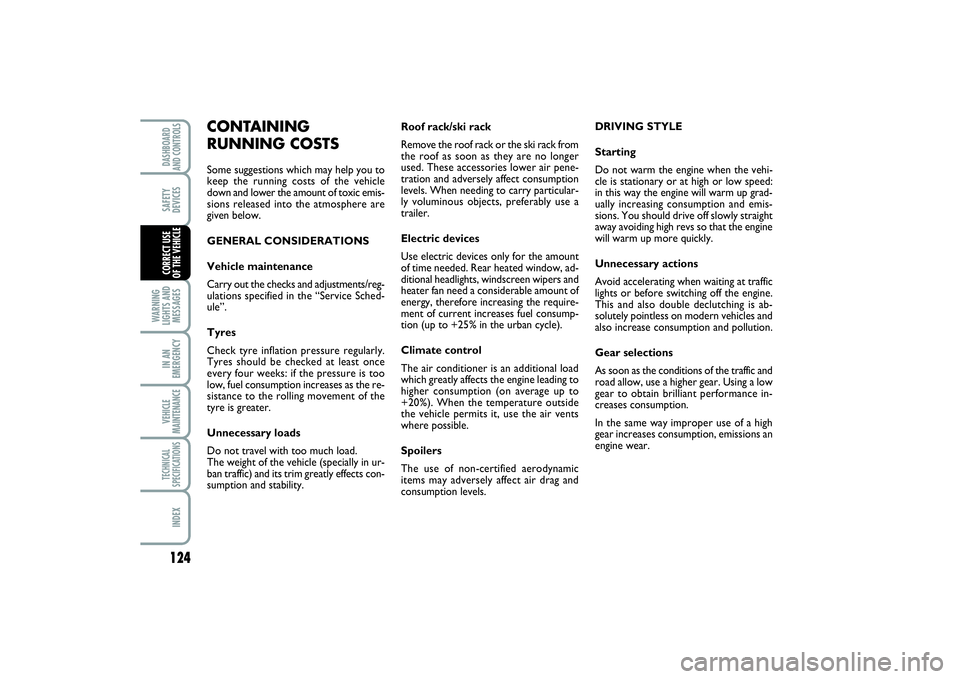
124WARNING
LIGHTS AND
MESSAGESIN AN
EMERGENCYVEHICLE
MAINTENANCETECHNICAL
SPECIFICATIONSINDEXDASHBOARD
AND CONTROLSSAFETY
DEVICESCORRECT USE
OF THE VEHICLE
Roof rack/ski rack
Remove the roof rack or the ski rack from
the roof as soon as they are no longer
used. These accessories lower air pene-
tration and adversely affect consumption
levels. When needing to carry particular-
ly voluminous objects, preferably use a
trailer.
Electric devices
Use electric devices only for the amount
of time needed. Rear heated window, ad-
ditional headlights, windscreen wipers and
heater fan need a considerable amount of
energy, therefore increasing the require-
ment of current increases fuel consump-
tion (up to +25% in the urban cycle).
Climate control
The air conditioner is an additional load
which greatly affects the engine leading to
higher consumption (on average up to
+20%). When the temperature outside
the vehicle permits it, use the air vents
where possible.
Spoilers
The use of non-certified aerodynamic
items may adversely affect air drag and
consumption levels.DRIVING STYLE
Starting
Do not warm the engine when the vehi-
cle is stationary or at high or low speed:
in this way the engine will warm up grad-
ually increasing consumption and emis-
sions. You should drive off slowly straight
away avoiding high revs so that the engine
will warm up more quickly.
Unnecessary actions
Avoid accelerating when waiting at traffic
lights or before switching off the engine.
This and also double declutching is ab-
solutely pointless on modern vehicles and
also increase consumption and pollution.
Gear selections
As soon as the conditions of the traffic and
road allow, use a higher gear. Using a low
gear to obtain brilliant performance in-
creases consumption.
In the same way improper use of a high
gear increases consumption, emissions an
engine wear.
CONTAINING
RUNNING COSTSSome suggestions which may help you to
keep the running costs of the vehicle
down and lower the amount of toxic emis-
sions released into the atmosphere are
given below.
GENERAL CONSIDERATIONS
Vehicle maintenance
Carry out the checks and adjustments/reg-
ulations specified in the “Service Sched-
ule”.
Tyres
Check tyre inflation pressure regularly.
Tyres should be checked at least once
every four weeks: if the pressure is too
low, fuel consumption increases as the re-
sistance to the rolling movement of the
tyre is greater.
Unnecessary loads
Do not travel with too much load.
The weight of the vehicle (specially in ur-
ban traffic) and its trim greatly effects con-
sumption and stability.
119-128 SCUDO LUM GB 18/11/13 14.26 Pagina 124
Page 133 of 227
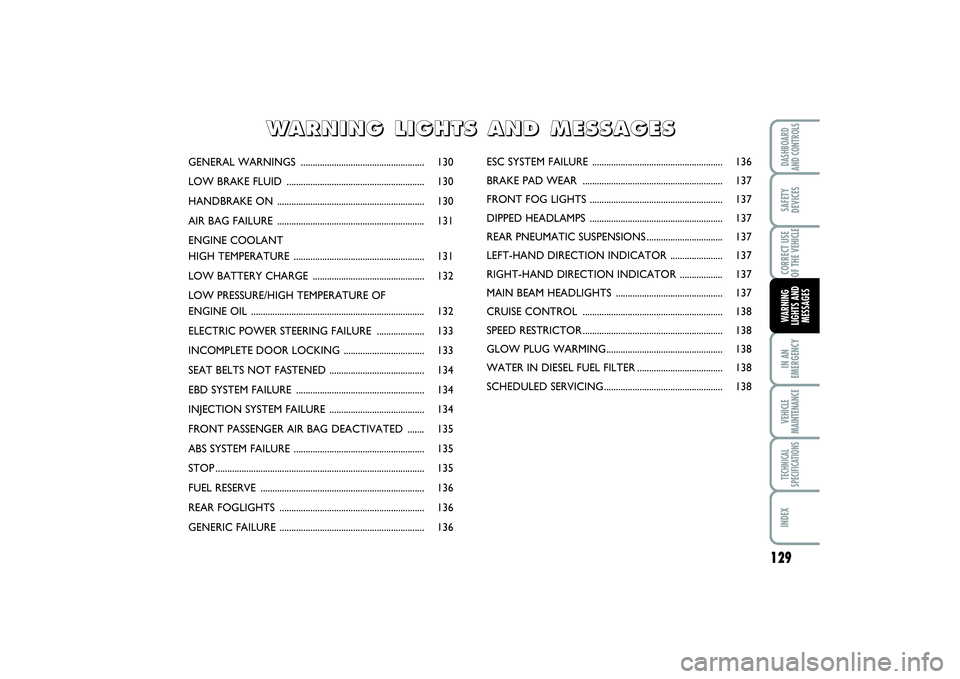
129
IN AN
EMERGENCYVEHICLE
MAINTENANCETECHNICAL
SPECIFICATIONSINDEXDASHBOARD
AND CONTROLSSAFETY
DEVICESCORRECT USE
OF THE VEHICLEWARNING
LIGHTS AND
MESSAGES
GENERAL WARNINGS .................................................... 130
LOW BRAKE FLUID .......................................................... 130
HANDBRAKE ON .............................................................. 130
AIR BAG FAILURE .............................................................. 131
ENGINE COOLANT
HIGH TEMPERATURE ....................................................... 131
LOW BATTERY CHARGE ............................................... 132
LOW PRESSURE/HIGH TEMPERATURE OF
ENGINE OIL ......................................................................... 132
ELECTRIC POWER STEERING FAILURE .................... 133
INCOMPLETE DOOR LOCKING .................................. 133
SEAT BELTS NOT FASTENED ........................................ 134
EBD SYSTEM FAILURE ...................................................... 134
INJECTION SYSTEM FAILURE ........................................ 134
FRONT PASSENGER AIR BAG DEACTIVATED ....... 135
ABS SYSTEM FAILURE ....................................................... 135
STOP ........................................................................................ 135
FUEL RESERVE ..................................................................... 136
REAR FOGLIGHTS ............................................................. 136
GENERIC FAILURE ............................................................. 136ESC SYSTEM FAILURE ....................................................... 136
BRAKE PAD WEAR ........................................................... 137
FRONT FOG LIGHTS ........................................................ 137
DIPPED HEADLAMPS ........................................................ 137
REAR PNEUMATIC SUSPENSIONS ................................ 137
LEFT-HAND DIRECTION INDICATOR ...................... 137
RIGHT-HAND DIRECTION INDICATOR .................. 137
MAIN BEAM HEADLIGHTS ............................................. 137
CRUISE CONTROL ........................................................... 138
SPEED RESTRICTOR ........................................................... 138
GLOW PLUG WARMING................................................. 138
WATER IN DIESEL FUEL FILTER .................................... 138
SCHEDULED SERVICING.................................................. 138
W W
A A
R R
N N
I I
N N
G G
L L
I I
G G
H H
T T
S S
A A
N N
D D
M M
E E
S S
S S
A A
G G
E E
S S
129-138 SCUDO LUM GB 18/11/13 14.25 Pagina 129
Page 136 of 227
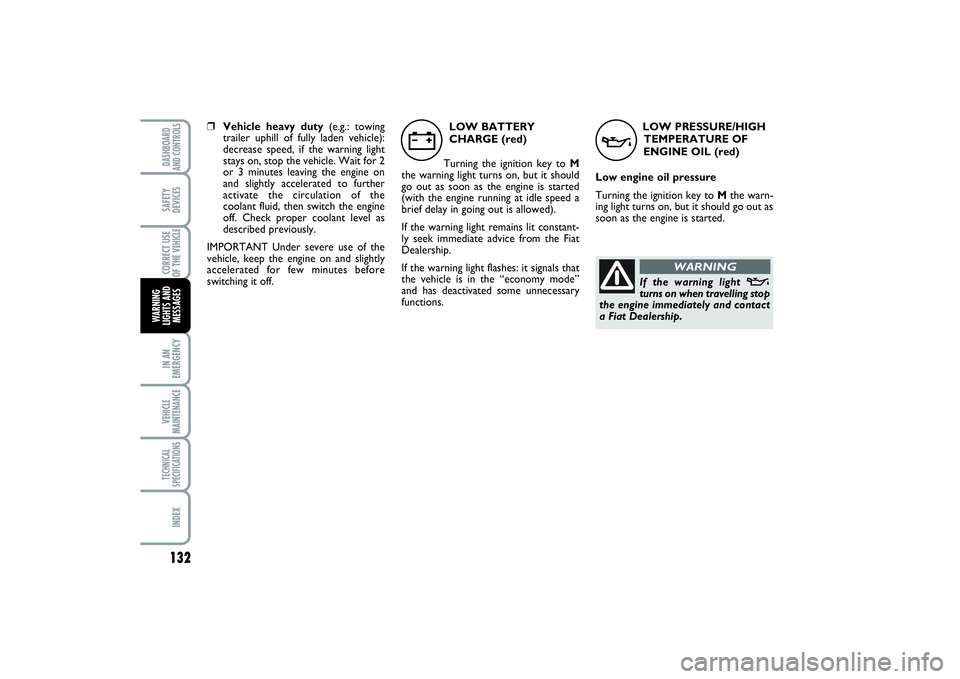
132IN AN
EMERGENCYVEHICLE
MAINTENANCETECHNICAL
SPECIFICATIONSINDEXDASHBOARD
AND CONTROLSSAFETY
DEVICESCORRECT USE
OF THE VEHICLE
WARNING
LIGHTS AND
MESSAGES
LOW PRESSURE/HIGH
TEMPERATURE OF
ENGINE OIL (red)
Low engine oil pressure
Turning the ignition key to Mthe warn-
ing light turns on, but it should go out as
soon as the engine is started.
v
If the warning light
v
turns on when travelling stop
the engine immediately and contact
a Fiat Dealership.
WARNING
❒Vehicle heavy duty(e.g.: towing
trailer uphill of fully laden vehicle):
decrease speed, if the warning light
stays on, stop the vehicle. Wait for 2
or 3 minutes leaving the engine on
and slightly accelerated to further
activate the circulation of the
coolant fluid, then switch the engine
off. Check proper coolant level as
described previously.
IMPORTANT Under severe use of the
vehicle, keep the engine on and slightly
accelerated for few minutes before
switching it off.LOW BATTERY
CHARGE (red)
Turning the ignition key to M
the warning light turns on, but it should
go out as soon as the engine is started
(with the engine running at idle speed a
brief delay in going out is allowed).
If the warning light remains lit constant-
ly seek immediate advice from the Fiat
Dealership.
If the warning light flashes: it signals that
the vehicle is in the “economy mode”
and has deactivated some unnecessary
functions.
w
129-138 SCUDO LUM GB 18/11/13 14.25 Pagina 132
Page 137 of 227
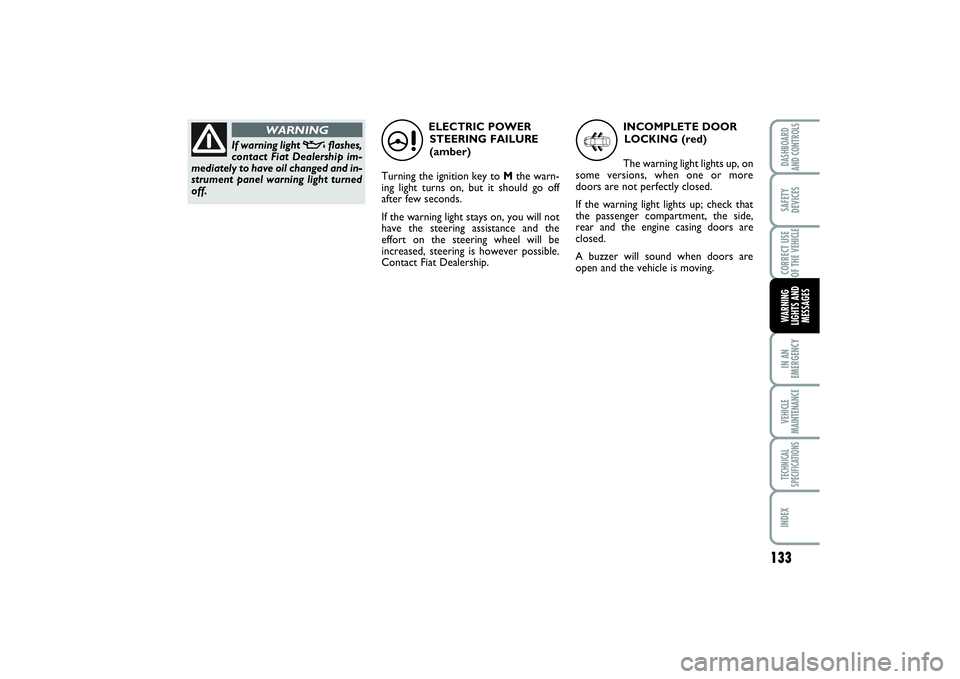
133
IN AN
EMERGENCYVEHICLE
MAINTENANCETECHNICAL
SPECIFICATIONSINDEXDASHBOARD
AND CONTROLSSAFETY
DEVICESCORRECT USE
OF THE VEHICLEWARNING
LIGHTS AND
MESSAGES
ELECTRIC POWER
STEERING FAILURE
(amber)
Turning the ignition key to Mthe warn-
ing light turns on, but it should go off
after few seconds.
If the warning light stays on, you will not
have the steering assistance and the
effort on the steering wheel will be
increased, steering is however possible.
Contact Fiat Dealership.
If warning light
v
flashes,
contact Fiat Dealership im-
mediately to have oil changed and in-
strument panel warning light turned
off.
WARNING
»
INCOMPLETE DOOR
LOCKING (red)
The warning light lights up, on
some versions, when one or more
doors are not perfectly closed.
If the warning light lights up; check that
the passenger compartment, the side,
rear and the engine casing doors are
closed.
A buzzer will sound when doors are
open and the vehicle is moving.
9
129-138 SCUDO LUM GB 18/11/13 14.25 Pagina 133
Page 166 of 227
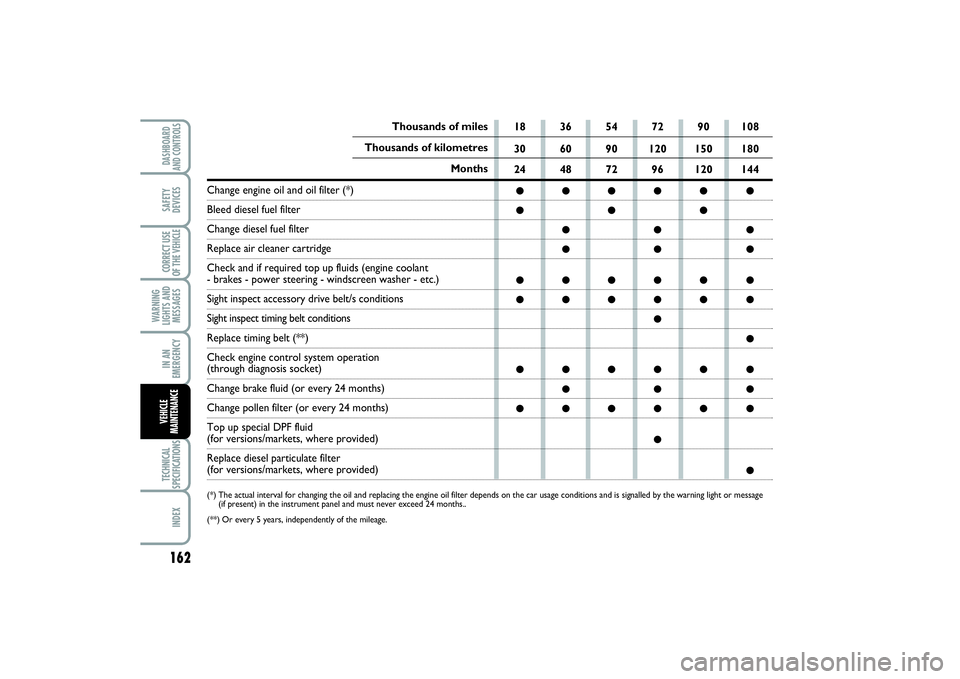
162WARNING
LIGHTS AND
MESSAGESTECHNICAL
SPECIFICATIONSINDEXDASHBOARD
AND CONTROLSSAFETY
DEVICESCORRECT USE
OF THE VEHICLEIN AN
EMERGENCYVEHICLE
MAINTENANCE
18 36 54 72 90 108
30 60 90 120 150 180
24 48 72 96 120 144●●●●● ●
●●●
●● ●
●● ●
●●●●● ●
●●●●● ●
●
●
●●●●● ●
●● ●
●●●●● ●
●
●
Thousands of miles
Thousands of kilometres
Months
Change engine oil and oil filter (*)Bleed diesel fuel filterChange diesel fuel filterReplace air cleaner cartridge
Check and if required top up fluids (engine coolant- brakes - power steering - windscreen washer - etc.)Sight inspect accessory drive belt/s conditionsSight inspect timing belt conditionsReplace timing belt (**)
Check engine control system operation(through diagnosis socket)Change brake fluid (or every 24 months)Change pollen filter (or every 24 months)
Top up special DPF fluid (for versions/markets, where provided)
Replace diesel particulate filter (for versions/markets, where provided) (*) The actual interval for changing the oil and replacing the engine oil filter depends on the car usage conditions and is signalled by the warning light or message
(if present) in the instrument panel and must never exceed 24 months..
(**) Or every 5 years, independently of the mileage.
159-178 SCUDO LUM GB 12/12/13 10.02 Pagina 162
Page 167 of 227
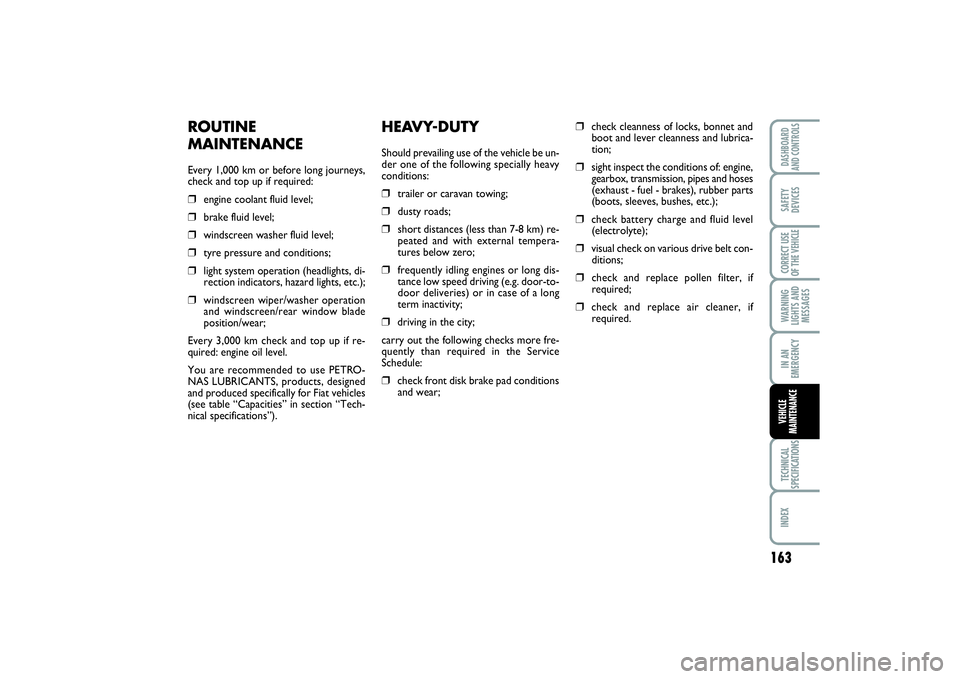
163
WARNING
LIGHTS AND
MESSAGESTECHNICAL
SPECIFICATIONSINDEX DASHBOARD
AND CONTROLSSAFETY
DEVICESCORRECT USE
OF THE VEHICLEIN AN
EMERGENCYVEHICLE
MAINTENANCE
HEAVY-DUTYShould prevailing use of the vehicle be un-
der one of the following specially heavy
conditions:❒
trailer or caravan towing;
❒
dusty roads;
❒
short distances (less than 7-8 km) re-
peated and with external tempera-
tures below zero;
❒
frequently idling engines or long dis-
tance low speed driving (e.g. door-to-
door deliveries) or in case of a long
term inactivity;
❒
driving in the city;
carry out the following checks more fre-
quently than required in the Service
Schedule:
❒
check front disk brake pad conditions
and wear;
❒
check cleanness of locks, bonnet and
boot and lever cleanness and lubrica-
tion;
❒
sight inspect the conditions of: engine,
gearbox, transmission, pipes and hoses
(exhaust - fuel - brakes), rubber parts
(boots, sleeves, bushes, etc.);
❒
check battery charge and fluid level
(electrolyte);
❒
visual check on various drive belt con-
ditions;
❒
check and replace pollen filter, if
required;
❒
check and replace air cleaner, if
required.
ROUTINE
MAINTENANCEEvery 1,000 km or before long journeys,
check and top up if required:❒
engine coolant fluid level;
❒
brake fluid level;
❒
windscreen washer fluid level;
❒
tyre pressure and conditions;
❒
light system operation (headlights, di-
rection indicators, hazard lights, etc.);
❒
windscreen wiper/washer operation
and windscreen/rear window blade
position/wear;
Every 3,000 km check and top up if re-
quired: engine oil level.
You are recommended to use PETRO-
NAS LUBRICANTS, products, designed
and produced specifically for Fiat vehicles
(see table “Capacities” in section “Tech-
nical specifications”).
159-178 SCUDO LUM GB 12/12/13 10.02 Pagina 163
Page 168 of 227
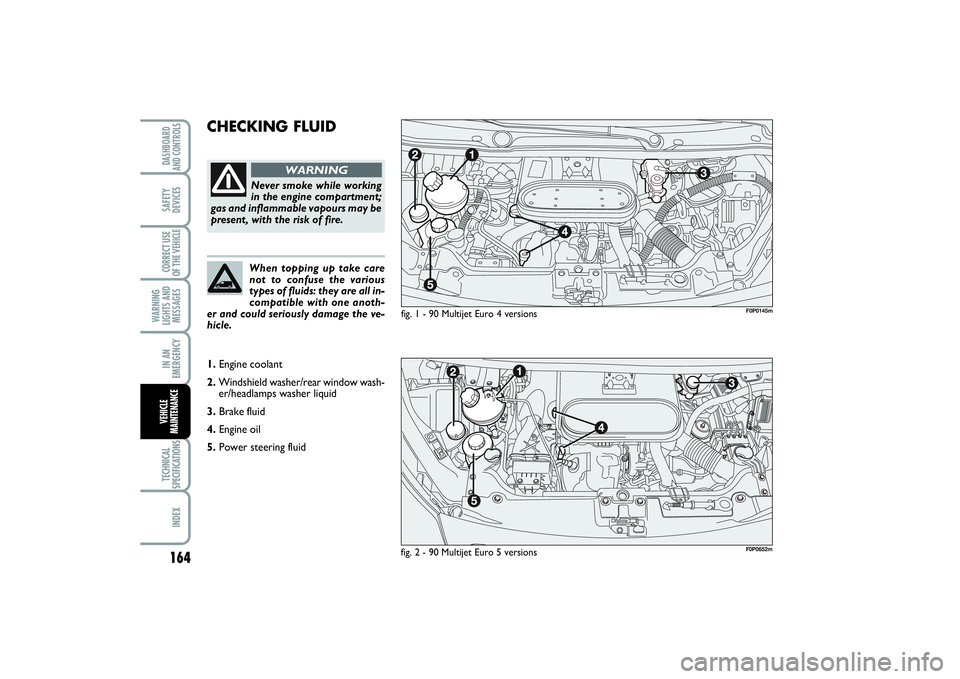
164WARNING
LIGHTS AND
MESSAGESTECHNICAL
SPECIFICATIONSINDEXDASHBOARD
AND CONTROLSSAFETY
DEVICESCORRECT USE
OF THE VEHICLEIN AN
EMERGENCYVEHICLE
MAINTENANCE
CHECKING FLUID
fig. 1 - 90 Multijet Euro 4 versions
Never smoke while working
in the engine compartment;
gas and inflammable vapours may be
present, with the risk of fire.
WARNING
When topping up take care
not to confuse the various
types of fluids: they are all in-
compatible with one anoth-
er and could seriously damage the ve-
hicle.
F0P0145m
1.Engine coolant
2.Windshield washer/rear window wash-
er/headlamps washer liquid
3.Brake fluid
4.Engine oil
5.Power steering fluid
fig. 2 - 90 Multijet Euro 5 versions
F0P0652m
159-178 SCUDO LUM GB 12/12/13 10.02 Pagina 164
Page 169 of 227
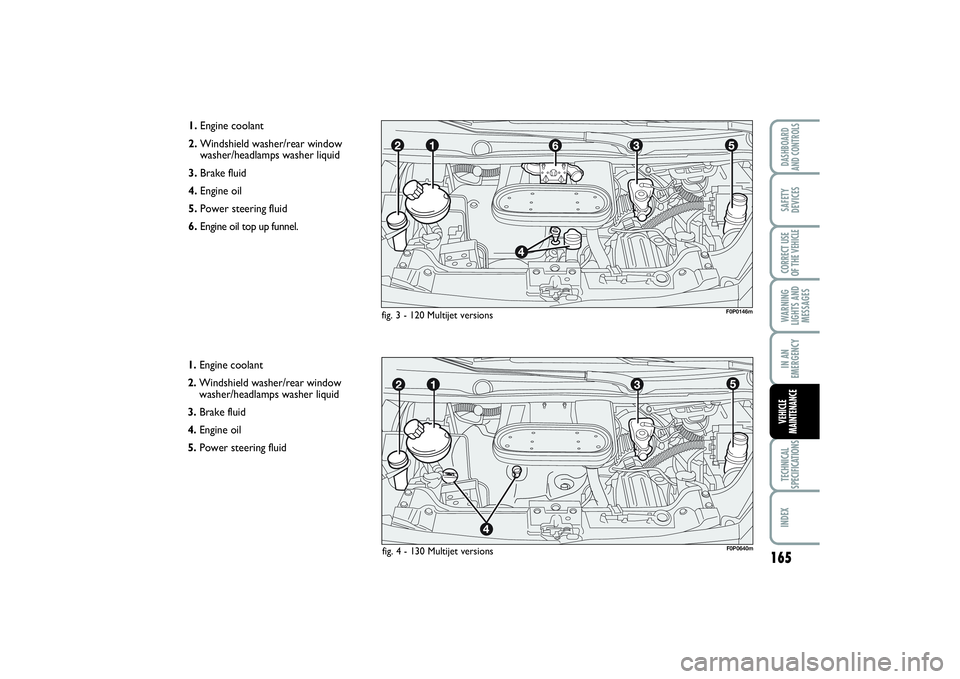
165
WARNING
LIGHTS AND
MESSAGESTECHNICAL
SPECIFICATIONSINDEX DASHBOARD
AND CONTROLSSAFETY
DEVICESCORRECT USE
OF THE VEHICLEIN AN
EMERGENCYVEHICLE
MAINTENANCE
1.Engine coolant
2.Windshield washer/rear window
washer/headlamps washer liquid
3.Brake fluid
4.Engine oil
5.Power steering fluid
6.Engine oil top up funnel.
1.Engine coolant
2.Windshield washer/rear window
washer/headlamps washer liquid
3.Brake fluid
4.Engine oil
5.Power steering fluid
F0P0146m
fig. 3 - 120 Multijet versions
F0P0640m
fig. 4 - 130 Multijet versions
159-178 SCUDO LUM GB 12/12/13 10.02 Pagina 165